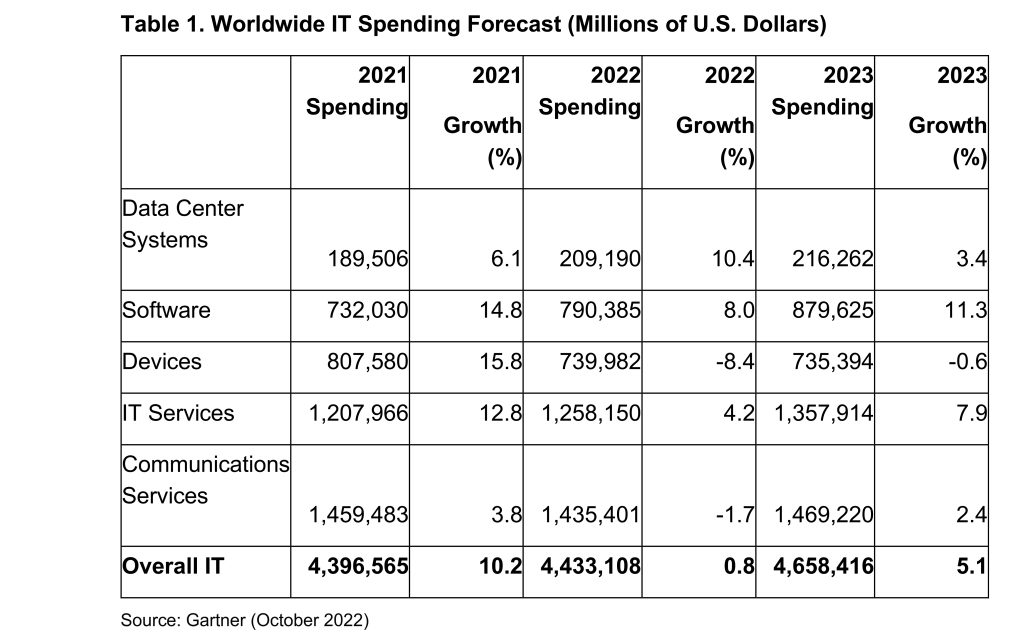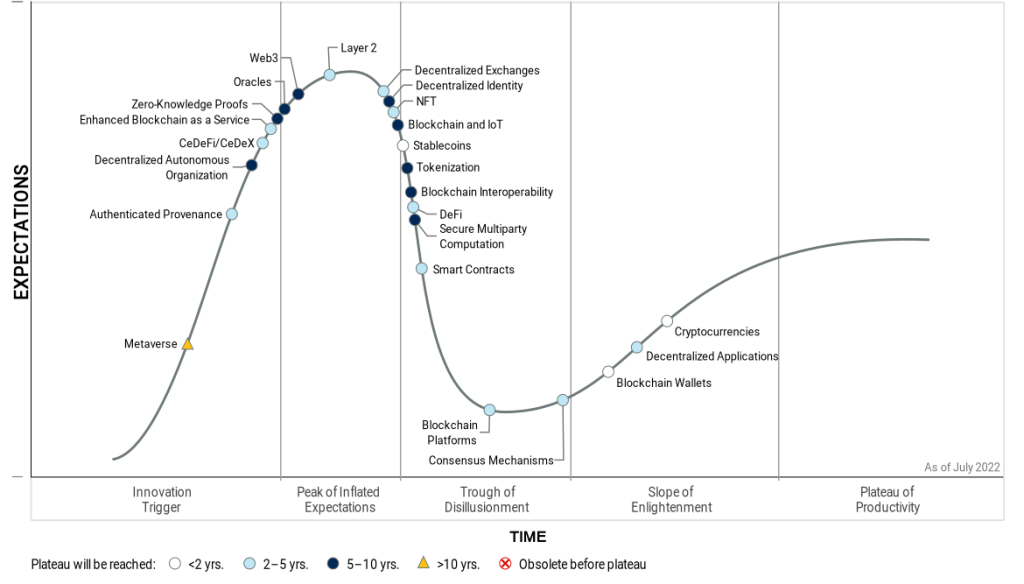As 2022 ended contractors and analysts alike were optimistically starting the journey into 2023 with confidence. Or not. Gartner is putting forth its IT predictions and warnings, getting executives ready for the challenges that are certainly coming, some that can cause serious headaches if not met.
For example, worldwide IT spending is projected to total $4.6 trillion in 2023, an increase of 5.1% from 2022. Demand for IT in 2023 is expected to be strong, as enterprises push forward with digital business initiatives in response to economic turmoil. According to Gartner’s analysts, enterprise IT spending is recession-proof as CEOs and CFOs, rather than cutting IT budgets, are increasing spending on digital business initiatives.
However, inflation has cut into consumer purchasing power in almost every country around the world. Consumer purchasing power has been reduced to the point that many consumers are now deferring 2022 device purchases until 2023, driving spending on devices down 8.4% in 2022 and 0.6% in 2023.
The technologies that are being maintained versus those that are driving the business are evident by their projected growth rates in 2023. There is sufficient spending within data center markets to maintain existing on-premises data centers, but new spending continues to shift to cloud options, as evidenced by the 11.3% projected growth for software spending in 2023.

A July 2022 Gartner survey of more than 200 CFOs found 69% plan to increase their spend on digital technologies, while the 2023 Gartner CIO and Technology Executive Survey found CIOs are being tasked with accelerating time to value on digital investments. The outlook is companies will use digital technology primarily to reshape their revenue stream, adding new products and services, changing the cash flow of existing products and services, as well as changing the value proposition of existing products and services. This trend has fed the shift from buying technology to building, composing, and assembling technology to meet specific business drivers. This shift is foundational to the growth of cloud over on-premises for new IT spending.
Digital Investments
In a down or deteriorating economy, conventional wisdom calls for reducing costs, including IT costs. However, as organizations look to also realize operations efficiency, cost reductions, and/or cost avoidance during the current economic uncertainty, more traditional backoffice and operational needs of departments outside IT are being added to the digital transformation project list.
In 2023, delivering technology will not be enough. To enhance their organization’s financial position during times of economic turbulence, CIOs and IT executives must look beyond cost savings to new forms of operational excellence while continuing to accelerate digital transformation. It is critical for companies to examine where technologies can help organizations optimize resilience, operations or trust, scale vertical solutions and product delivery, and pioneer with new forms of engagement, accelerated responses, or opportunity.
These themes are impacted by ESG (environmental, social, and governance) expectations and regulations, which translate into the shared responsibility to apply sustainable technologies. Every technology investment will need to be set off against its impact on the environment, keeping future generations in mind. ‘Sustainable by default’ as an objective requires sustainable technology.
Here Comes 2023
The top strategic technology trends for 2023:
Sustainability
Sustainability covers all the strategic technology trends for 2023. In a recent Gartner survey, CEOs reported environmental and social changes are now a top three priority for investors, after profit and revenue. This means that executives must invest more in innovative solutions that are designed to address ESG demand to meet sustainability goals. To do this, organizations need a new sustainable technology framework that increases the energy and material efficiency of IT services, enables enterprise sustainability through technologies like traceability, analytics, renewable energy, and AI while deploying IT solutions to help customers achieve their own sustainability goals.
Metaverse
Gartner defines a metaverse as a collective, virtual 3D shared space, created by the convergence of virtually enhanced physical and digital reality. A metaverse is persistent, providing enhanced immersive experiences. Gartner expects a complete metaverse will be device-independent and won’t be owned by a single vendor. It will have a virtual economy of its own, digital currencies, and NFTs (non-fungible tokens) created in blockchains.
Blockchain technologies have matured enough to support many business applications, but we still have not witnessed “killer apps” that have caught on in the enterprise. Generally, enterprise adoption of blockchain is moving slower than consumer adoption, although this is historically the path that emerging technologies take. Some innovations, such as blockchain wallets and smart contracts, are expected to reach maturity in less than five years, but other applications—for example, decentralized identity and NFTs—face technical, regulatory, and interoperability challenges that are hindering business adoption.
Overall, the majority of blockchain innovations will reach maturity within two to 10 years. By 2027, Gartner predicts more than 40% of large organizations worldwide will use a combination of Web3, AR cloud, and digital twins in metaverse-based projects aimed at increasing revenue.
Web3 uses a stack of technologies, based on decentralized blockchains, that enables new business and social models. Users own their data, identity, content, and algorithms and participate as “shareholders” by owning the protocol’s tokens or cryptocurrencies. That ownership shifts power and money away from centralized Web 2.0 “gatekeepers,” such as big tech companies and governments.

Superapps
A superapp combines the features of an application, a platform, and an ecosystem all in one. It not only has its own set of functionalities, but it also provides a platform for third parties to develop and publish their own mini-apps. By 2027, Gartner predicts more than 50% of the global population will be daily active users of multiple superapps.
Although most examples of superapps are mobile apps, the concept can also be applied to desktop client applications, such as Microsoft Teams and Slack, with the key being that a superapp can consolidate and replace multiple apps for customer or employee use.
Adaptive AI
Adaptive AI (artificial intelligence) systems aim to continuously retrain models and apply machine learning, within runtime and development environments and based on new data, to adapt quickly to changes in real-world circumstances that were not expected or available during initial development. They use realtime feedback to change their learning dynamically and adjust goals. This makes them suitable for operations where rapid changes in the external environment or changing enterprise goals require an optimized response.
Digital Immune System
Seventy-six percent of teams responsible for digital products are now also responsible for revenue generation. CIOs are looking for new practices and approaches that their teams can adopt to deliver that high business value, along with mitigating risk and increasing customer satisfaction. A digital immune system provides such a roadmap.
Digital immunity combines data-driven insight into operations, automated and extreme testing, automated incident resolution, software engineering within IT operations, and security in the application supply chain to increase the resilience and stability of systems. Gartner predicts by 2025, organizations that invest in building digital immunity will reduce system downtime by up to 80%—and that translates directly into higher revenue.
Applied Observability
Observable data reflects the digitized artifacts, such as logs, API (application programming interface) calls, dwell time, downloads, and file transfers that appear when any stakeholder takes any kind of action, a digital trail. Applied observability feeds these observable artifacts back in a highly orchestrated and integrated approach to accelerate organizational decision-making.
Applied observability is powerful because it elevates the strategic importance of the right data at the right time for rapid action based on confirmed stakeholder actions, rather than intentions. When planned strategically and executed successfully, applied observability is the most powerful source of data-driven decision-making.
AI Trust, Risk, and Security Management
Many organizations are not well prepared to manage AI risks. A Gartner survey in the U.S., U.K., and Germany found 41% of organizations had experienced an AI privacy breach or security incident. However, that same survey found organizations that actively managed AI risk, privacy, and security achieved improved AI project results. More of their AI projects moved from proof-of-concept status into production and achieved more business value than did AI projects in organizations that did not actively manage these functions.
Industry Cloud Platforms
By 2027, Gartner predicts more than 50% of enterprises will use industry cloud platforms to accelerate their business initiatives. Industry cloud platforms offer a combination of SaaS (software as a service), PaaS (platform as a service), and IaaS (infrastructure as a service), providing industry-specific sets of modular capabilities to support specific industry business use cases. Enterprises can use the packaged capabilities of industry cloud platforms as building blocks to compose unique and differentiating digital business initiatives, providing agility, innovation, and reduced time to market, while avoiding lock-in.
Platform Engineering
Platform engineering is the discipline of building and operating self-service internal developer platforms for software delivery and lifecycle management. The goal of platform engineering is to optimize the developer experience and accelerate product teams’ delivery of customer value. Gartner predicts 80% of software engineering organizations will establish platform teams by 2026 and that 75% of those will include developer self-service portals.
Wireless Value Realization
While no single technology will dominate, enterprises will use a spectrum of wireless solutions to cater for all environments, from Wi-Fi in the office, through services for mobile devices, to low-power services and even radio connectivity. Gartner predicts by 2025, 60% of enterprises will be using five or more wireless technologies simultaneously. As networks move beyond pure connectivity, they will provide insight using built-in analysis and low-power systems will harvest energy directly from the network. This means the network will become a source of direct business value.
As inflation causes IT and all other departments to stop and carefully examine their spending plans, new technology and advanced versions of adopted tech are waiting in the wings, ready for deployment. Engineers, programmers, developers, and users are all anticipating a rise in demand for systems that will make business more productive, profitable, and predictable. And priced for adoption now.
Want to tweet about this article? Use hashtags #construction #sustainability #infrastructure #IoT #AI #5G #cloud #edge #futureofwork


